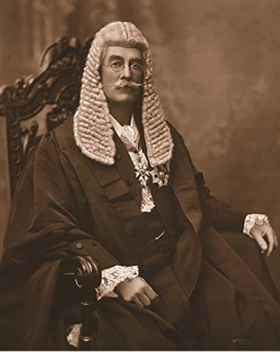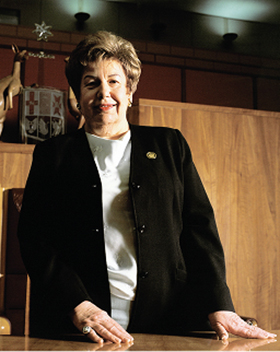The President of the Senate in the Australian Parliament is the presiding officer who chairs meetings of the Senate. The President is also the spokesperson for the Senate, who represents the Senate in dealings with the Governor-General, the executive government, the House of Representatives and persons outside the Parliament, and overseas.

Senator the Hon Sue Lines,
twenty-seventh President of the Senate
The position also has responsibilities relating to the administration of the Senate and the management of Parliament House. While the presidency is an office which was designed and has evolved particularly for the Australian federal Parliament, the role of the President in Parliament has its roots in the tradition of speakers of the houses of the British Parliament, and of the Australian colonial Parliaments.
The President is a senator, usually with some years of experience, who is elected to the position by the members of the Senate.
The current President of the Senate is Senator the Hon Sue Lines
First President of the Senate
Richard Chaffey Baker – 9 May 1901 to 31 December 1906
On the day of the first meeting of the Australian Senate, 9 May 1901, Senator Richard Baker was elected President of the Senate on the first ballot. He served a total of six years as President, being re-elected in 1904, and retired from the Senate at the end of 1906, when he did not stand for election.
Baker had a profound influence on the creation, founding and early development of the Senate, both as a framer of the Constitution, and as the presiding officer of the Senate during its earliest formative years.

Baker, the Hon. Sir Richard Chaffey, KCMG
A South Australian barrister who was first elected to the South Australian House of Assembly in 1868 at the age of 27, Baker was elected in 1877 to the Legislative Council. He became President of the Legislative Council in 1893, and his experience as a presiding officer in South Australia was to be significant for the procedural development of the new Australian Senate.
Baker was a representative for South Australia at the Australasian Federal Convention of 1891, where a draft constitution for a federated Australia was developed. He was widely read on constitutional and procedural matters and produced a list of readings for the delegates: A Manual of Reference to Authorities for the Use of the Members of the National Australasian Convention. Baker was elected to the federal Convention of 1897/8 where he was a powerful advocate of a new constitutional order for the Australian Commonwealth. He argued for a Senate that was a 'strong, a powerful, and a living house' which would be an equal partner with the House of Representatives in the consideration and review of legislation. Baker was the Chairman of Committees at that Convention.
In the first federal Parliament, as President of the Senate, Baker continued to assert the power and independence of the Senate. This was manifest in his contributions to the Standing Orders Committee, of which he was the first chairman, in his interpretations of standing orders in the Senate chamber, and in rulings on Senate practice supplementary to and explanatory of standing orders. The tradition of independence and originality commenced by the first President has been a model for subsequent presidents.
The first female President of the Senate
Senator Margaret Reid – 20 August 1996 to 18 August 2002

Reid, the Hon. Margaret Elizabeth
When elected in 1996, Margaret Reid became the nineteenth President of the Senate, and the first female President as well as the first territory President. A representative for the Australian Capital Territory from 1981, Senator Reid was an experienced senator who had held other positions in the Senate, including Liberal Party Whip, and Deputy President.
Senator Reid saw her role as President as that of a defender and champion of the institution of the Senate, saying at the time of her retirement: 'I have an abiding commitment to the role of this chamber and the way in which it does its business.'
A notable feature of her presidency was the support and assistance she offered to parliamentary institutions in developing countries of the South Pacific. Senator Reid was also an active delegate to parliamentary conferences in Australia and overseas, and was a president of the Commonwealth Parliamentary Association.
She had the distinction of being the President in office at the time of the celebrations for the centenary of Australian federation, and took leading roles in ceremonies at the Exhibition Building and Parliament House, Melbourne, on 9 and 10 May 2001. She also represented the Senate at centenary of federation ceremonies in London in July 2000.
The President's office
The President has a suite of rooms close to the Senate chamber. They comprise a large office and reception areas, including a dining room and a sitting room, where the President can greet and offer hospitality to visitors. There is also office accommodation for his staff: a senior advisor and two other advisors, and a receptionist. Traditionally, presidents have personalised the suite by choosing to display art works from the Parliament House art collection which reflect their interests and concerns, including reference to the state the President represents in the Senate.
The rooms open to two courtyards, divided by a glazed walkway. The walkway provides a direct route to the door in the Senate chamber behind the Vice-Regal Chair. During ceremonies for the opening of Parliament the Governor-General enters the chamber from the President's suite and walkway.
Traditional dress
Formal paintings of the first presiding officers in the Parliament House Art Collection show them wearing the costume of a judge of the Supreme Court, including knee breeches, silk stockings, and court shoes. This regalia reflected traditional parliamentary dress worn at Westminster, and is part of the ancient ceremonial of parliament. Early presidents generally wore a modified costume, comprising a black silk gown (similar to the gown worn by a Queen's Counsel) over a dark suit, lace accessories and a full-bottomed wig.
Senator Joseph Turley of Queensland, elected President on 1 July 1910, was the first Labor Party President. This cartoon from the Worker implies that there was consternation in the Senate when he chose not to wear the President's wig and gown. The subsequent President, Henry Thomas Givens, began wearing the traditional dress again in 1921, but no President has worn it since 1983.